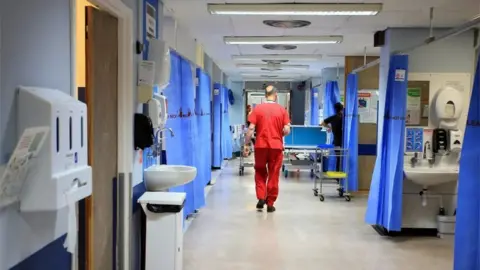What will the NHS 10-year plan look like?
 PA
PALong-term planning is rare in Whitehall with the five-year election cycle driving most policymaking.
But the NHS in England has a chance to break that mould with a 10-year plan.
That's what ministers have asked for - even though it will be a document which will possibly span the course of two future administrations, perhaps involving different political parties.
It sounds exciting and there was a widespread welcome for the idea when it was announced by Theresa May in June.
She challenged NHS England to come up with a 10-year plan which would include efficiency savings to reinvest back into patient care, should enjoy the support of NHS staff and not be centrally imposed.
The new money announced by the prime minister, though, covered five years rather than 10.
Real-terms funding increases of 3.4% were promised, which is considerably more than in recent years.
But some health economists pointed out that this rate of budget increase for the service was no more than what was seen in most previous decades and, in effect, would only cover the growth in patient demand.
It is a curious situation. Usually ministers demand a plan from the public sector before committing extra cash.
This time the NHS in England has been told what money it will get for five years and then been asked to come up with a plan over a longer time period.
What's more, NHS leaders have only been given four months to work up the strategy, one of which was the holiday month of August.
The deadline for NHS England to produce its work is in time for the budget in the autumn, presumably in November.
A lot of midnight oil will be need to be burned and there may be a feeling of a university-style "essay crisis".
A total of 19 different streams of work in different policy areas are under way.
NHS England has put out a consultation document calling for ideas and thoughts on key themes, such as early life, workforce and innovation.
The clinical priorities are listed as cancer, cardiovascular and respiratory, learning disability, and autism and mental health.
Responses from health organisations have been requested by the end of September.
Positive reactions
Health lobby groups who have trooped in for meetings with Simon Stevens and his leadership team at NHS England have trooped out in a generally cheerful mood.
They are pleasantly surprised by what they see as positive reactions to their ideas and apparent support for future spending.
But, as always, there are sceptics and mutterings. One senior health source said the short time frame for drawing up such a long term strategy was "ludicrous" and that the planning was inevitably "top down" with little chance of involving NHS staff.
There was a danger, according to the source, that expectations would be raised and disappointment would follow and a risk that there would not be a clear narrative in the plan.
It is a big ask for the NHS in England - find savings to invest in patient care, transform the delivery of services and work within a funding envelope which in the past has proved barely enough to match the continuing trend of rising demand for care in an ageing population.
On top of all that is the attempt to make local health and social care organisations work more closely together.
The latest performance figures for the NHS in England serve as another wake-up call. Key targets have been missed yet again.
The waiting list for non-urgent operations such as hip and knee replacements is the longest in more than a decade and above 4.1 million. The proportion of cancer patients who began treatment within the two-month target was the lowest since records began in 2009.
Niall Dickson, of the NHS Confederation, points out that radical thinking and more investment in GP and community health will be required but that "without meaningful investment in social care the NHS plan will fail".
Chris Hopson, of NHS Providers, argues that "we should not underestimate the challenges ahead in restoring performance, recovering finances, and integrating services to provide efficient, seamless care closer to home."
NHS England has many constituencies to please when it publishes the plan, ranging from the Treasury, who will want to feel there is value for money, to health groups, who want ambitious pledges.
It is a lot for Mr Stevens to think about as the deadline for his homework gets closer.
